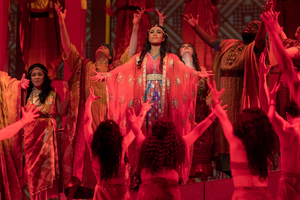Review: Washington National Opera's SAMSON AND DELILAH at the Kennedy Center

Bad haircuts can be tragic, but none more so than for Samson, the Biblical figure whose strength was sapped the moment his mullet was gone. The treacherous shearing by a revenge-seeking Delilah launched centuries of retelling, including Camille Saint-Saëns' opera "Samson and Delilah" which the Washington National Opera is currently presenting at the Kennedy Center in repertoire with "Don Giovanni."
It's the company's first performance of the work in 15 years, a sturdy work thats used to introduce a number of newcomers to the Kennedy Center stage.
Chief among them is J'Nai Bridges, the rising star who made her debut at the Met last fall. Striking and tall, Bridges chose opera over basketball back in Takoma, Wash., where she played on a state championship level. Her dark and rich mezzo-soprano was built for the famous pieces in the Saint-Saëns work, from "Printemps qui commence" ("Spring begins") to "Mon coeur s'ouvre à ta voix" ("My heart opens itself to your voice").
Taken under the wing of Denyce Graves, Bridges also sang at the Met's memorial for Jessye Norman in November. But she's also a big Beyoncé fan and knows how to hold an audience.
Clearly, she's poised for opera stardom, if she doesn't have it already. And the opening night audience (at a Sunday matinee) rippled with excitement, bringing a wider, more diverse audience to the Kennedy Center's Opera House than usual. Bridges may be the people's opera star: It was the first time I had seen bouquets for the star thrown from the audience instead of brought out by ushers.
But for a woman meant to be alluring even to her enemy, she seemed dressed in a lot of diaphanous capes by Timm Burrow, who adapted original costumes from Michael Scott of a previous production. Dancers in the third act's bacchanal, choreographed by Eric Sean Fogel, were dressed more seductively
Opposite her, Italian tenor Roberto Aronica was a formidable Sampson, who in the production directed by Peter Kazaras, stood with strength as the world roiled around him - first amid his fellow countrymen, jailed; and then jailed and blinded after being tricked and captured. The power of his early encouragement to the Israelites in Gaza, "Arrêtez, ô mes frères" ("Stop, O my brothers") is diminished only slightly when he returns, nearly beaten and newly shorn with "Vois ma miser hulas! ("Behold my misery, alas!" in the third act.
Of the other principals, Noel Bouley, Tómas Tómmasson and Matthew Pearce are faultless. Three others - Matthew Pearce, Samuel J. Weiser and Joshua Blue - acquitted themselves well as members of the company's apprentice Domingo-Cafritz Artist Program (that had its name changed Tuesday to the Cafritz Young Artists of Washington National Opera "in light of recent developments" surrounding Placido Domingo).
The robust bass Peter Volpe as The Old Hebrew had his own opening performance cheering squad, a group associated with Indiana University, where he teaches. While here, the busy Volpe is also singing the part of Don Ottavio in "Don Giovanni."
Also doing double duty is set designer Erhard Rom, whose effective and geometric framing is used for the other production as well, working well with the swirling projections of clouds and explosions by S. Katy Tucker.
Performed in French with English subtitles, Saint-Saëns's "Samson and Delilah" seemed to have it all - lovely arias, huge choral pieces, dance, pageantry, and the story of temptation and lust at its core.
Originally intended as an oratorio, it's a treat to hear the mighty voices of the Washington National Opera chorus rise up when it does.
Conductor John Fiore, also making his debut with this pair of productions, kept the energy and lyricism up, and won a measure of extra applause for his effort.
Director Kazaras has a lot to move around, with, in addition to the seven principals, the 52 member chorus, the 12 dancers, the 10 supernumaries and four children. But it moves admirably, even in the final act, with the dancing around a huge bust of the god Dagon in a group that also includes Bridges..
The libretto hardly needed much of Samson's Biblical back story, spectacular as it was (slaying a lion, killing 1,000 men with the jawbone of an ass). Instead, it concentrated on Sampson's single-handed freeing of the Israelis from the hands of the Philistines, his inexplicable attraction to the daughter of the Philistine's high priest (there were other women in the world, even then) and his subsequent jailing following the deception and retribution once he's finally shared the secret of his strength.
Kazaras said in a post-show Q&A that "simulated sexual intimacy is never very interesting on stage." Still, things seemed especially chaste in the production, with the two principals ducking behind a curtain in a bedroom, where shadows show only an embrace before the hair is cut - an event also seen only in shadows. The locks were brought forth triumphantly from behind the curtain as if it were a newborn. Bad haircuts being not very interesting on stage either, apparently.
Running time: About three hours, including one intermission.
Photo credit: J'Nai Bridges in WNO's "Samson and Delilah." Photo by Scott Suchman
"Samson and Delilah" plays March 4, 7, 13, 16 and 21 at the Kennedy Center for the Performing Arts, 2700 F St NW. Tickets at 202-467-4600 or online.
Reader Reviews

Videos

